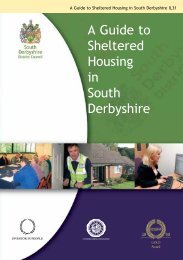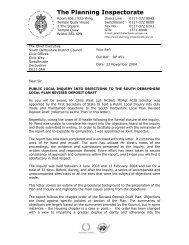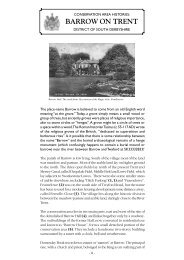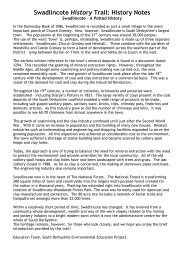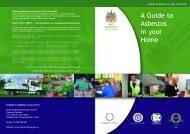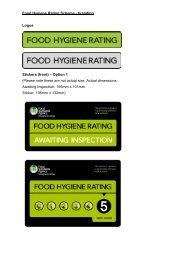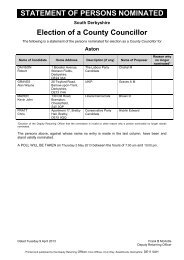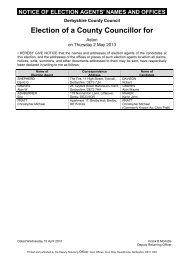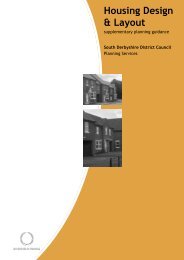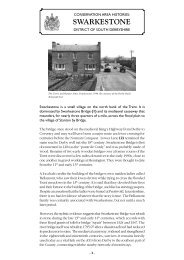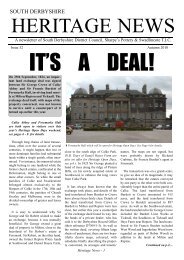Housing Strategy 2009-2014 - South Derbyshire District Council
Housing Strategy 2009-2014 - South Derbyshire District Council
Housing Strategy 2009-2014 - South Derbyshire District Council
Create successful ePaper yourself
Turn your PDF publications into a flip-book with our unique Google optimized e-Paper software.
<strong>South</strong> <strong>Derbyshire</strong> <strong>District</strong> <strong>Council</strong> <strong>Housing</strong> <strong>Strategy</strong> <strong>2009</strong> – <strong>2014</strong><br />
1. A STRATEGY FOR SOUTH DERBYSHIRE<br />
1.1 Profile of the <strong>District</strong><br />
1.1.1 <strong>South</strong> <strong>Derbyshire</strong> covers an area of about 340 square kilometres and has a<br />
population of 91,000 1 . The district population has grown by some 12% between<br />
2001 and 2007 making it the sixth fastest growing local authority area in England<br />
and Wales.<br />
1.1.2 Swadlincote is the main administrative and commercial centre of the district where<br />
approximately a third of the population live. The town is located on the former<br />
<strong>South</strong> <strong>Derbyshire</strong> coalfields. Coal and clay workings have all but disappeared.<br />
The rest of the district is mostly rural in character, marked by open countryside,<br />
the valleys of the Trent and Dove and a patchwork of villages and settlements.<br />
1.1.3 According to the 2001 Census, the district’s population age structure is broadly<br />
similar to the national average, but with a marginally higher proportion of people<br />
of working age. At the 2001 Census, some 3% of the population classified<br />
themselves as ‘non-white’. The largest ethnic minority group is ‘Asian or Asian<br />
British’ accounting for some 1.6% with the majority residing in the parish of<br />
Stenson Fields which borders Derby City in the north of the district.<br />
1.1.4 The 2001 Census shows that household average size for the district is at 2.43<br />
compared to 2.35 for <strong>Derbyshire</strong> and 2.36 for England. The most common<br />
household size in <strong>South</strong> <strong>Derbyshire</strong> is two-person household (40%) followed by<br />
single person households (23%) 2 .<br />
1.1.5 In November 2008, <strong>South</strong> <strong>Derbyshire</strong> had an unemployment rate of 1.6%.<br />
Whilst this is lower than that for <strong>Derbyshire</strong> (2.5%) and England (2.8%) there are<br />
some wards, which have rates above the national average. These include Newhall<br />
and Stanton at 3.0% and Woodville at 3.1%.<br />
1.1.6 In the Indices of Multiple Deprivation 2007 <strong>South</strong> <strong>Derbyshire</strong> is ranked 235th<br />
out of 354 in England and Wales. There are considerable variations across the<br />
district where some parts of the district such as Hartshorne are amongst the most<br />
deprived areas the county.<br />
1.1.7 Businesses in <strong>South</strong> <strong>Derbyshire</strong> employ some 27,000 3 people of which the service<br />
sector provides the majority (62%) followed by manufacturing (29%). The high<br />
level of manufacturing can be attributed to the presence of Toyota at Burnaston.<br />
1<br />
Office National Statistics Mid 2007 Estimate reported in 21 August 2008 News Release report available<br />
from: http://www.statistics.gov.uk/pdfdir/popest0808.pdf<br />
2<br />
<strong>South</strong> <strong>Derbyshire</strong> Strategic <strong>Housing</strong> Market Assessment 2007/08.<br />
3<br />
Official Labour Market Statistics available from:<br />
https://www.nomisweb.co.uk/reports/lmp/la/2038431980/report.aspx<br />
2



